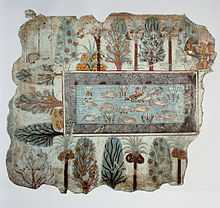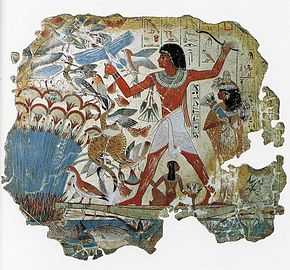Nebamun

Nebamun was an Egyptian "scribe and counter of grain" during the New Kingdom.[1] His tomb in Thebes, the location of which is now lost, featured the famous Pond in a Garden fresco, executed a secco.[1]
Nebamun's name is translated as "My Lord is Amun" and he is thought to have lived c. 1350 BCE.[2] The paintings were hacked from the tomb wall and purchased by a British collector who in turn sold them to the British Museum in 1821. The collector died in poverty without ever revealing the source location of the paintings.[3] The depictions are highly symbolic and thematically related to a joyful afterlife.
In 2009 the British Museum opened up a new gallery dedicated to the display of the restored eleven wall fragments from Nebamun's tomb, described as one of the Museum's greatest treasures.[4]
Gallery
-

Fowling scene
-

Dancers and musicians
References
- ↑ 1.0 1.1 Wilkins, David G; Schultz, Bernard; Linduff, Katheryn M (2009), Art past, art present, Pearson/Prentice Hall, ISBN 978-0-13-601541-3
- ↑ British Museum Room 61 http://www.britishmuseum.org/explore/galleries/ancient_egypt/room_61_tomb-chapel_nebamun.aspx
- ↑ A happy ending with a pinch of Salt. Al-Ahram Weekly Online, 19-25 March 2009, No. 939. Retrieved 20 January 2015.
- ↑ Campbell-Johnston, Rachel (January 13, 2009). "New Egyptian gallery at the British Museum". The Times.
External links
- This article is about an item held in the British Museum. The object reference is Room 61.
| ||||||||||||||||||||||
| Wikimedia Commons has media related to Tomb of Nebamun. |
